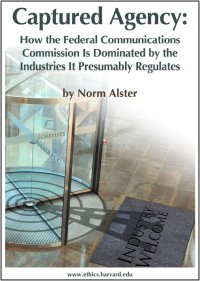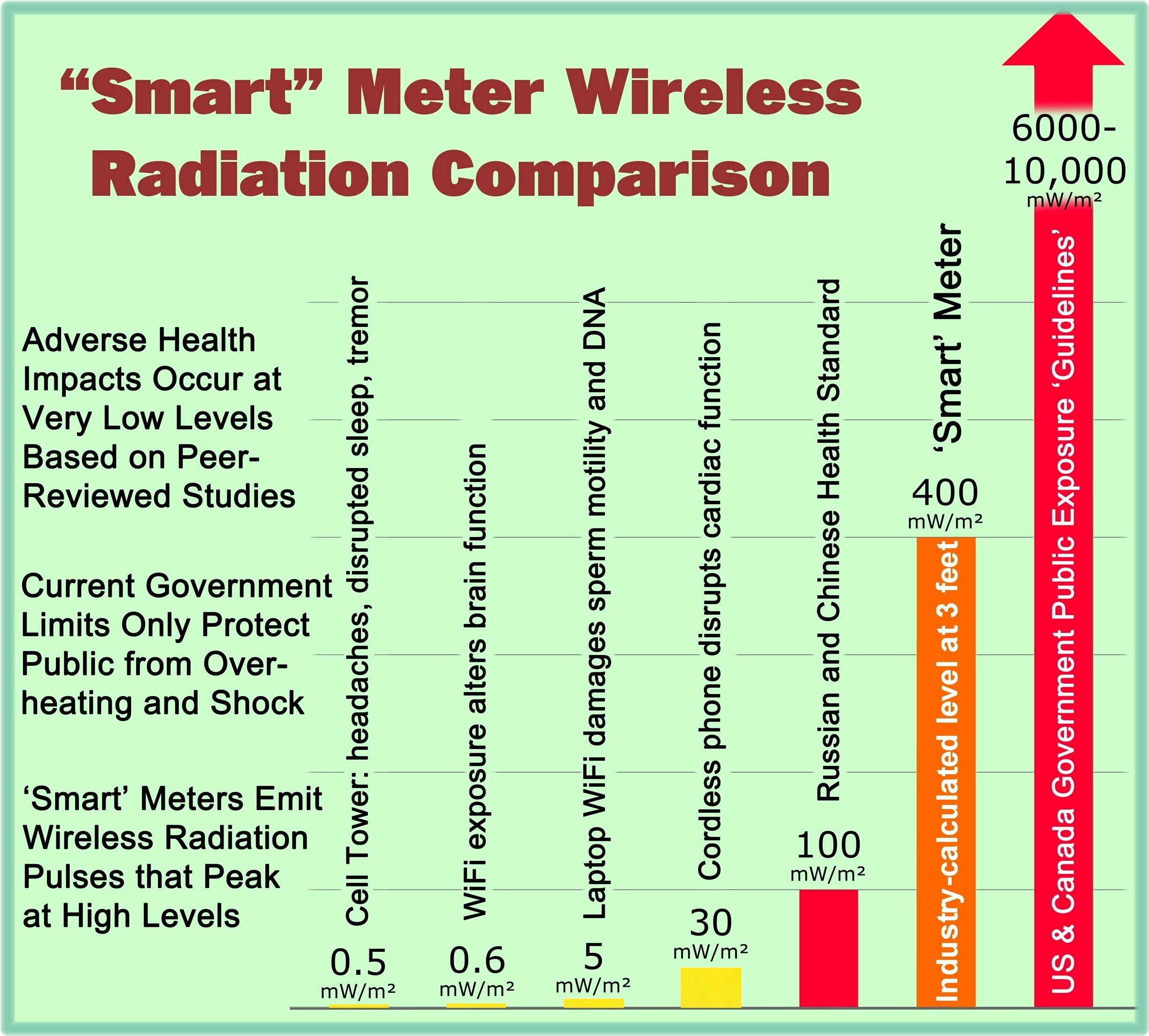The U. S. Department of Interior (DOI) has declared that exposure standards used by the Federal Communications Commission (FCC) are “out of date and inapplicable today.”
 After reading the information provided in this blog article, maybe we can start a campaign to have some personnel transferred from the Department of Interior to the FCC. The people at the DOI seem to have a better grasp on the hazards of radiofrequency (RF) radiation and might be more inclined to take measures to protect humans as well as fauna and flora.
After reading the information provided in this blog article, maybe we can start a campaign to have some personnel transferred from the Department of Interior to the FCC. The people at the DOI seem to have a better grasp on the hazards of radiofrequency (RF) radiation and might be more inclined to take measures to protect humans as well as fauna and flora.
What follows are excerpts from a letter dated February 7, 2014, from the United States Department of the Interior and addressed to the National Telecommunications and Information Administration of the United States Department of Commerce. This letter highlights the Interior Department’s concern that cell tower RF radiation emissions have had negative impacts on the health of migratory birds, their offspring, and other wildlife species.

“The Department believes that … proposed procedures are not consistent with Executive Order 13186 Responsibilities of Federal Agencies to Protect Migratory Birds, … The Department, through the Fish and Wildlife Service (FWS), finds that the proposals lack provisions necessary to conserve migratory bird resources, including eagles. The proposals also do not reflect current information regarding the effects of communication towers to birds.”
“The Department recommends revisions to the proposed procedures to better reflect the impacts to resources under our jurisdiction from communication towers. The placement and operation of communication towers, including un-guyed, unlit, monopole or lattice-designed structures, impact protected migratory birds in two significant ways. The first is by injury, crippling loss, and death from collisions with towers and their supporting guy-wire infrastructure, where present. The second significant issue associated with communication towers involves impacts from non-ionizing electromagnetic radiation emitted by them.”
Background
“Radiation studies at cellular communication towers were begun circa 2000 in Europe and continue today on wild nesting birds. Study results have documented nest and site abandonment, plumage deterioration, locomotion problems, reduced survivorship, and death (e.g., Balmori 2005, Balmori and Hallberg 2007, and Everaert and Bauwens 2007). Nesting migratory birds and their offspring have apparently been affected by the radiation from cellular phone towers in the 900 and 1800 MHz frequency ranges – 915 MHz is the standard cellular phone frequency used in the United States.
… [T]he electromagnetic radiation standards used by the Federal Communications Commission (FCC) continue to be based on thermal heating, a criterion now nearly 30 years out of date and inapplicable today. This is primarily due to the lower levels of radiation output from microwave-powered communication devices such as cellular telephones and other sources of point-to-point communications; levels typically lower than from microwave ovens. The problem, however, appears to focus on very low levels of non-ionizing electromagnetic radiation. For example, in laboratory studies, T. Litovitz (personal communication) and DiCarlo et al. (2002) raised concerns about impacts of low-level, non-thermal electromagnetic radiation from the standard 915 MHz cell phone frequency on domestic chicken embryos – with some lethal results (Manville 2009, 2013a).
Radiation at extremely low levels (0.0001 the level emitted by the average digital cellular telephone) caused heart attacks and the deaths of some chicken embryos subjected to hypoxic conditions in the laboratory while controls subjected to hypoxia were unaffected (DiCarlo et al. 2002). To date, no independent, third-party field studies have been conducted in North America on impacts of tower electromagnetic radiation on migratory birds.
With the European field and U.S. laboratory evidence already available, independent, third-party peer-reviewed studies need to be conducted in the U.S. to begin [examining] the effects from radiation on migratory birds and other trust species.”
Discussion
“There is a growing level of anecdotal evidence linking effects of non-thermal, non-ionizing electromagnetic radiation from communication towers on nesting and roosting wild birds and other wildlife in the U.S. Independent, third-party studies have yet to be conducted in the U.S. or Canada, although a peer-reviewed research protocol developed for the U.S. Forest Service by the Service’s Division of Migratory Bird Management is available to study both collision and radiation impacts (Manville 2002).
As previously mentioned, Balmori (2005) found strong negative correlations between levels of tower-emitted microwave radiation and bird breeding, nesting, and roosting in the vicinity of electromagnetic fields in Spain. He documented nest and site abandonment, plumage deterioration, locomotion problems, reduced survivorship, and death in House Sparrows, White Storks, Rock Doves, Magpies, Collared Doves, and other species. Though these species had historically been documented to roost and nest in these areas, Balmori (2005) did not observe these symptoms prior to construction and operation of the cellular phone towers. Balmori and Hallberg (2007) and Everaert and Bauwens (2007) found similar strong negative correlations among male House Sparrows. Under laboratory ‘conditions, DiCarlo et al. (2002) raised troubling concerns about impacts of low-level, non-thermal electromagnetic radiation from the standard 915 MHz cell phone frequency on domestic chicken embryos – with some lethal results (Manville 2009). Given the findings of the studies mentioned above, field studies should be conducted in North America to validate potential impacts of communication tower radiation both direct and indirect – to migratory birds and other trust wildlife species.”
The content of the above-mentioned Department of Interior (DOI) letter is encouraging in that it reveals that at least some people within our government seem to understand (and acknowledge) the potential hazards associated with radiofrequency (RF) radiation emissions. However, much of the content of the DOI letter is not new; most of the same documented concerns can be found in a presentation given by Albert Manville II, Ph.D. of the U.S. Fish and Wildlife Service during a Congressional staff briefing in 2007 (link below).
Manville Wildlife Presentation 2007
Additionally, in a paper from 2009, Manville has a section entitled, “Possible Tower Radiation Issues,” where he states:
“Virtually unknown, however, are the potential effects of non-ionizing, non-thermal tower radiation on avifauna, including at extremely low radiation levels, far below the safe exposure level previously determined for humans. These ‘safe’ levels were based on thermal heating standards, now inapplicable. The standards are now more than 25 years out of date, and the U.S. Environmental Protection Agency (EPA) office tasked to direct human safety issues was eliminated due to budget cuts in the early 1980s. No government agency currently monitors the rising background levels of electromagnetic radiation (EMF). Current safety standards assume that non-ionizing radiation is safe if the power is too weak to heat living tissue. However, since the 1980s, growing amounts of published research are showing adverse effects far below a thermal threshold—usually referred to as ‘nonthermal effects,’ especially under conditions of long-term, low-level exposure.”
“In 2002 in the U.S., T. Litovitz (2002 pers. comm., DeCarlo et al. 2002) raised troubling concerns about the impacts of low-level, non-thermal radiation from the standard 915 MHz cell phone frequency on domestic chicken embryos (Gallus domesticus) under laboratory conditions (DeCarlo et al. 2002). Litovitz noted deformities, including some deaths of the embryos subjected to hypoxic conditions under extremely low radiation doses. These included doses as low as 1/10 000 below the allowable EPA ‘safe’ level of radiation.”
“Although Beason and Semm (2002) tested the natural responses of Zebra Finches (Taeniopygia guttata) to 900 MHz radiation under laboratory conditions and showed that 76% of the neurons responded by 3.5-times more firings, no studies have yet been conducted in the U.S. on potential radiation impacts to wild bird populations.”
 In a document issued by the FCC in March 2012, entitled “Final Programmatic Environmental Assessment for the Antenna Structure Registration Program,” it is stated that:
In a document issued by the FCC in March 2012, entitled “Final Programmatic Environmental Assessment for the Antenna Structure Registration Program,” it is stated that:
“[L]aboratory studies have been interpreted to suggest that non-ionizing RF radiation at levels far below the existing exposure guidelines for humans may have harmful effects on wild birds. However, the evidence is insufficient to support a finding that there may be adverse impacts on migratory bird populations due to RF radiation emissions.” [emphasis added]
There appears to be no basis for the FCC to draw the conclusion that “evidence is insufficient.” The FCC merely makes that conclusion.
An apparent explanation for the FCC conclusion would be the sentiment indicated earlier in the report that “at relatively low levels of exposure to RF radiation, the evidence for harmful biological effects on wildlife is unproven.” [emphasis added] This expresses the non-conservative and irrational logic used for humans regarding RF exposure, that unless almost unattainable “proof” can be obtained, no actions may be considered or taken to protect a species, i.e., … substantial evidence less than absolute “proof” is “insufficient” to support a finding of adverse impacts.
I suppose the real question is how long can the substantial evidence of adverse effects “fall upon deaf ears” at the FCC and elsewhere?






IS THERE ANYWAY TO ELDERLY PARENTS HOME CHECKED FOR SEVERE RADIATION…IONIZING RADIATION
Your question appears to be based upon an urgent concern but is not specific enough to offer much advice. “Ionizing radiation” is the type of radiation given off by x-ray machines, nuclear medicine treatments, nuclear power plants, or other similar emission sources. The types of radiation sources discussed at this website primarily deal with non-ionizing radiation such as radiofrequency (RF) fields from cell phones, Wi-Fi, smart meters, and the like. Although some people have their own instruments for measuring RF fields in their homes, if you don’t or aren’t skilled in performing such measurements on your own, then it is recommended to contact an environmental consultant, building biologist, or possibly even a knowledgeable friend who may be able to perform the measurements for you.
Pingback: WI Smart Meter Minute: Wisconsin Public Service Corporation refuses customer access to their data | Stop Smart Meters Wisconsin
Thank God, there is at least one Federal Agency that has taken steps to address this vital growing concern.
Pingback: US Department of Interior Attacks FCC's Exposure Standards: "Out of Date and Inapplicable" | TBYP